On 23 August 2008, in the Slovenian mountains, in both the Julian and Kamnik and Savinja Alps, the police alpine unit carried out a common preventive action to provide the general safety of walkers, hikers and mountaineers.
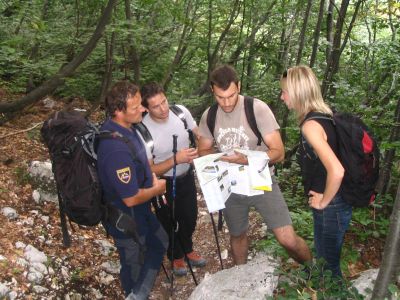
As part of the preventive action of the police in the mountains in July and activities in the jurisdictions of individual police directorates, policemen gave advice, directions and warnings to visitors to the mountains in the following areas:
- Planina Blato - Sedmera jezera - Komarča
- Vršič - Mojstrovka - Vršič
- Kamniška Bistrica - Repov kot - Srebrno sedlo - Planjava
- Mangrtsko sedlo
- Vrata - Luknja - Plamenica - Triglav - Vrata
- Kališče - Storžič - Velika Polana - Kališče
- Lepena - Krnska jezera - Krn - Lepena
They were advised on the importance of safe walking, the clothes and shoes to wear, the importance of entering their names in the register of mountain visitors and monitoring weather forecasts, etc.
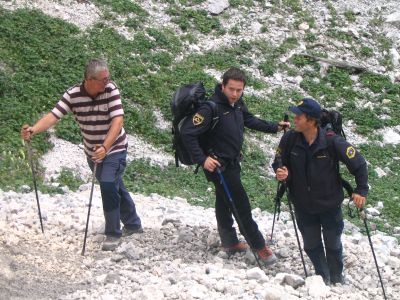
According to the morning information from the meteorological service at Krederica about the coming storm, already reaching the Julian Alps at noon, all police patrols participating in the preventive action on 23 August informed all mountaineers they met during the climb about the severe danger of heavy storms with rain and lightning and possible snow during the night.
 The storm is coming
The storm is coming
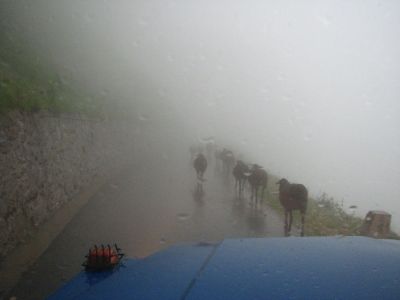
Even sheep ran into the valley to hide from the storm
Due to severe life-threatening conditions, the police directed three foreigners in the area of Mojstrovka to go to the valley, and in the area of Triglav warned seven mountaineers and eight tourists, as well as five Slovenians and seven foreign mountaineers in the area of Mangart. After the descent into the valley all the mountaineers thanked the police for their help, especially those near Mangart, where the policemen helped a family with three children aged from 4 to 8 descend safely.
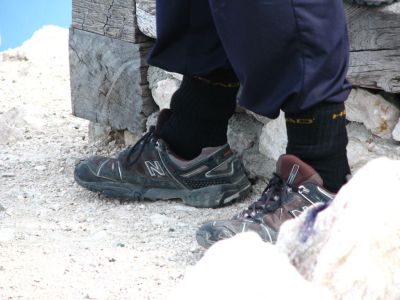
Inappropriate shoes: at the top of Mangart in sports shoes and below
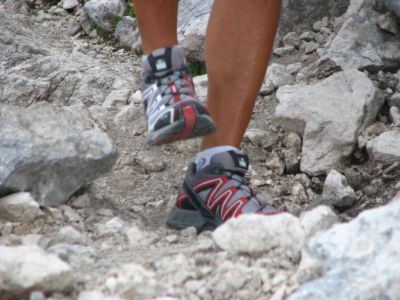
Policemen warned 41 mountaineers, 18 Slovenian citizens and 23 tourists, of which most were Hungarians, Poles and Czechs, because of their inappropriate clothes and equipment (shoes, helmet) and above all because of a definite forecast of bad weather in the mountains. All 18 Slovenian mountaineers respected the warnings of the police immediately, along with 18 foreigners; however, five of them went further to Triglav in sports shoes, although they were warned that during the night snow would fall above 2000 m and the descent would be very dangerous.
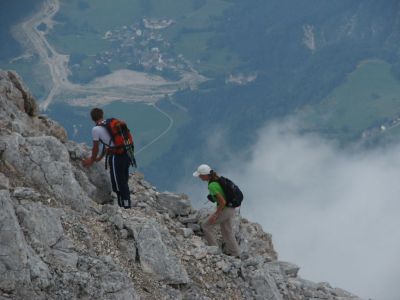
Despite many deaths last year due to falling rocks, more than half of mountaineers walking on secured road are still not wearing helmets
According to the chief of preventive action, Robert Kralj, assistant to the chief of the mountaineering unit operating within the special police unit, underestimating the mountains can be extremely dangerous: We cannot even imagine what mountaineers expect when they continue their climb despite loud thunder and black clouds covering the peaks of mountains and detailed weather forecasts with explicit warnings about storms, and without any equipment for camping out. We notice that foreigners go to our mountains when passing Slovenia to other countries, and this is also shown by their inappropriate equipment: sports shoes, shorts and t-shirts, and small 15-litre rucksacks usually carried only by one person in the group while the others do not have one at all. However, they all have maps of the Julian Alps but cannot comprehend the difficulty and length of the road and do not know the characteristics and insidiousness of our mountains. As an example, two foreign tourists wearing leisure shoes and shorts and t-shirts (the man was carrying a small rucksack and a map of the Julian Alps) were heading for "Stenar" on the road below Sovatna at 12.30 pm when some precipitation started to fall. An experienced mountaineer needs three hours from that point and rocks prevail in the upper part of the trail. Luckily, they respected our warning and went back to the valley immediately.
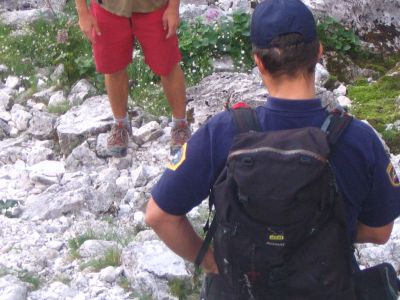
Some advice
Preparations for a climb or hike:
- Start the climb or hike early enough to avoid summer storms in the afternoon or noon heat, and in all other seasons avoid nightfall and therefore a careless return to the valley.
- Find information about the weather (danger of summer storms, etc.) and the type of the mountain route; this will make your climb easier and will enable better preparation for it.
- The aim of your climb or walk is undoubtedly a safe return home and not only conquering the peak. Don't forget that when you reach the peak, you still have half way to go. If you can, choose a more difficult path for the climb and an easier one for the descent, and above all do not hurry.
- You should choose the climb according to your health condition. Sultry weather and high temperatures can be fatal to certain individuals. We do not recommend climbing hills for persons who have health problems of any kind. Before the climb, see a doctor.
- The difficulty of the route dictates different mountaineering equipment. A part of the necessary personal equipment is proper alpine shoes, because soft shoes are dangerous. In your rucksack you should carry snacks, drinks, personal documents, gloves, a cap, an anorak, sun cream, sunglasses, spare clothes, compasses, a mountain map, first aid in protective foil, a whistle, a bivouac - sleeping bag, matches, candle, a torch and a mobile phone. According to the chosen path, additional specialised tools must be considered (climbing rope, ice-pick, sometimes also crampons and a helmet).
- You should find a companion to go climbing with you, because walking alone in the mountains is risky and potentially fatal, even if you get a mild injury. It is recommended that you go with a guide from the Slovenian Mountaineering Association or a mountain guide from the Association of Slovenian Mountain Guides, or at least with someone who knows the route well.
- You should inform your family or friends about the intended route and time you will need, because they can then take appropriate steps if you do not come back at the agreed hour due to an accident.
- If you wish to spend the night in a mountain cottage, you should get information beforehand regarding operating hours and book a night there.
- Mountaineers should only take marked routes, because most accidents happen on unmarked roads; searching for injured people outside the marked routes is more difficult, and when choosing unmarked trails reckless people endanger not only themselves if they provoke rock slides but also other mountaineers on the trail.
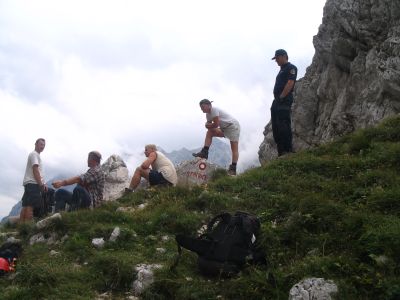 Walking into the mountains:
Walking into the mountains:
- Start slowly to warm up. Set a steady pace and try to find and keep it, even as part of a bigger group.
- The walk should be safe, comfortable and efficient. You should have enough time for a safe walk, and you should monitor the surroundings and keep your ears "open" - falling stones can often be accompanied by a rumbling sound.
- The basic pace, breaks and duration of the walk should be determined by the weakest member in the group. You should take a few-minutes' break every hour.
- If you go to the mountains with children, pay special attention to them and adapt to them completely.
- For safety reasons, mountaineers should enter their names in the register kept by mountain cottages.
- Keep your eyes open when walking. Mountains do not allow us to be absent-minded. A well marked alpine path is only a precondition and a possibility for you to reach your goal, because as a visitor to the mountains you must be familiar with basic orientation.
- While walking you should constantly observe the weather and adjust your plans accordingly. If you see storm clouds approaching, you must stay away from ridges and other exposed parts because they are usually targets of lightning.
- Longer rests should be taken at places which are safe and comfortable. Regular snacks and drinking liquids will prevent exhaustion and dehydration.
- Make sure you take back everything you brought with you.
- When you feel the first signs of fatigue or exhaustion, stop for a longer break. If you feel the slightest nausea or chest pain, immediately stop climbing or descending. Immediately call the emergency number 112 and they will put you in touch with doctors - alpine rescuers who will advise you over the phone until rescuers reach you.
- In the event of an accident, save your energy and find shelter while you can.
- It is the duty of all visitors to the mountains to help in accidents as much as they can.
- Firstly, you should protect the injured person from further injury and give him/her first aid. As soon as possible inform the alpine rescue team by calling the number 112 or police number 113 about the accident.

